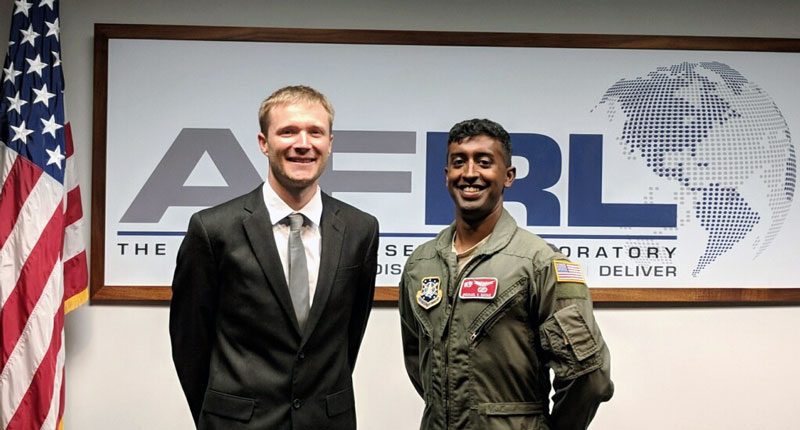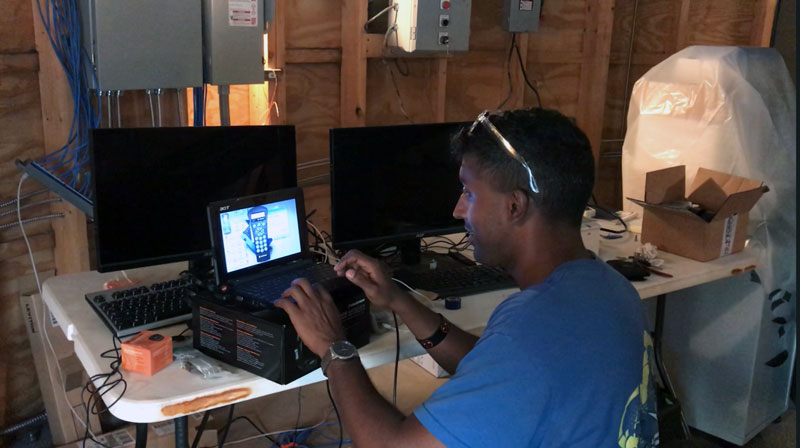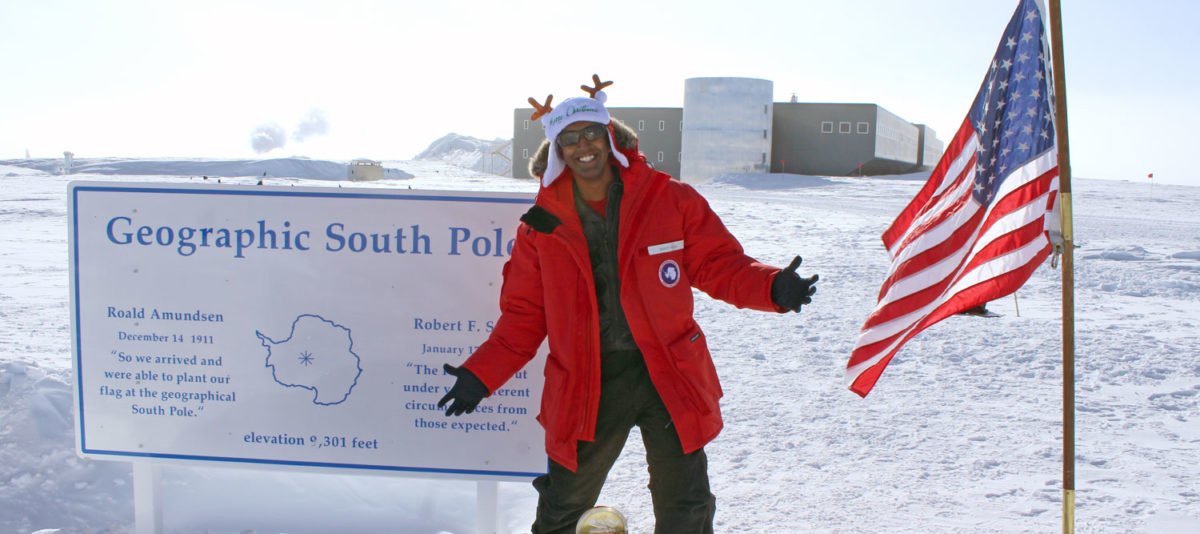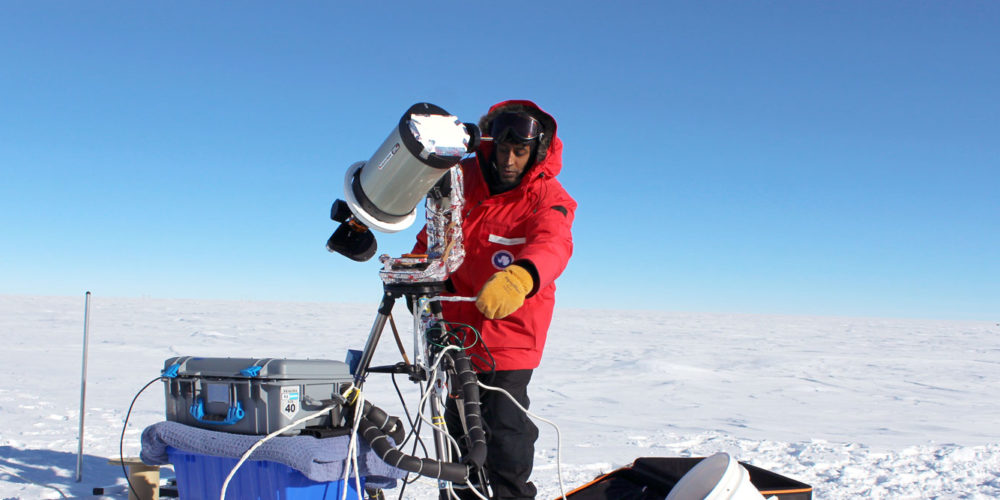In 2018, an Embry-Riddle alumnus installed the only optical telescope currently at the South Pole to better understand how our solar system evolved, and in particular, why Jupiter orbits in an icy realm beyond the asteroid belt. The knowledge gained could overturn popular scientific theory and narrow the search for extraterrestrial life forms.
“What we learn through this project could change the way we think about our solar system,” says Capt. Michael “Mikey” Nayak, Ph.D., a scientist with the U.S. Air Force Research Laboratory (AFRL).
In many other solar systems, explains Nayak (’10), hot Jupiter-like planets spin closely around their stars. “They’re fairly common in all of the exosystems we’ve studied so far,” he notes. That begs the question: Why is our own solar system so different?
Nayak’s mission to set up the Long-Duration Antarctic Day and Night Imaging Telescope (LANDIT) promises to provide new clues to this fundamental mystery of planetary science. In addition, observational methods developed for the project — supported by the Air Force Office of Scientific Research (AFOSR), the U.S. Air Force Test Pilot School and the National Science Foundation (NSF) — might someday suggest a way to peek inside human-made satellites in space, including non-U.S. satellites that could pose a threat to national security.
A Marriage of Science and Engineering

The effort sprang from a unique agreement, signed by the heads of the Air Force and the NSF, to marry scientific and engineering basic research. With a bachelor’s and master’s degree in aerospace engineering from Embry-Riddle and two Earth and planetary science degrees from the University of California, Santa Cruz, Nayak’s expertise and military background were perfect for the mission. Co-directing the project with Nayak is astronomer Ryan Swindle, Ph.D., an AFRL research physicist.
During the Antarctic summer in November and December 2018, Nayak flew to the Amundsen-Scott South Pole Station to install a small prototype telescope, make measurements of the atmosphere, and practice observing Jupiter, as well as Saturn, during continuous daylight hours. The only active military member resident at the South Pole during the 2018-19 season, he will return next December with a seven-person team to test-drive a larger telescope during Antarctic days and nights.
If all goes well, Nayak and Swindle’s Ph.D. student, Embry-Riddle alumnus Cody Shaw (’15), a space physicist, will return in 2020 to capture the first-ever 100-day set of long-term or “seismic” signals from Jupiter and Saturn. These signals — minute changes in reflected light, uninterrupted by the rising sun — are only possible to observe from Antarctica.
Harmonic Vibrations
Using those signals, researchers can glean what’s inside Jupiter and Saturn, and how they have changed over time. If the signals remain uninterrupted, the background noise should be low enough to determine the acoustic modes that continuously vibrate around and through planets. These “spherical harmonics” are a kind of gravitational song that can be mathematically expressed to reveal the shape of a planet. After they identify a planet’s song at the surface, researchers can better understand its interior. Interior shapes such as lumps can be imagined as musical notes that tell a story about the planet’s formation and evolution. The approach is an adaptation of a field known as helioseismology.

The key question is whether Jupiter evolved closer to the Sun in ancient times, but then hurtled into its current position after engaging in a game of gravitational tug-of-war with Saturn, Nayak says. If it evolved closer to the sun — a popular theory — its core and mantle would be shaped very differently than if it formed further out in the solar system, under much colder temperatures.
“What we learn could provide insights to the past and future evolution of our solar system,” Nayak says.
Extraterrestrial Life
Understanding Jupiter’s ancient origins might also help narrow the search for life on distant moons, says Nayak’s former teacher, satellite expert Bogdan Udrea, associate professor of aerospace engineering at Embry-Riddle. Europa, a moon or natural satellite of Jupiter, is covered with ice, but some researchers think it may harbor water, and thus, microbial or other life forms.
“Once we know how Europa evolved around Jupiter, we want to extrapolate from that model to look for other moons that might harbor life,” says Udrea, who received a 2017 AFRL Summer Faculty Fellowship that supported this research.

Commercial Space Application
The potential for other applications for this science also exists. If researchers can model the interior of Jupiter using seismic signals detected by LANDIT and the resulting mathematical data, similar models might gauge how much fuel is left in the tanks of human-made satellites in orbit, Udrea says. His undergraduate students Zachary Henry and Graham Fox are working to model how the light reflected by a small satellite changes due to fuel sloshing in its tanks.
Nayak cites Stacie Williams, Ph.D., the project officer who runs the remote-sensing initiatives for the AFOSR, as an “inspirational human being” and a key champion of the LANDIT mission.
He also credits his Embry-Riddle education. “To make something work over the winter at the South Pole, when it can reach negative 90 degrees Celsius — it’s a whole other level of engineering,” Nayak says.
Editor’s note: In January 2019, Nayak started training at U.S. Air Force Test Pilot School. He expects to graduate in December as an experimental flight test engineer. He still plans to be a part of the LANDIT mission.
